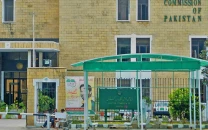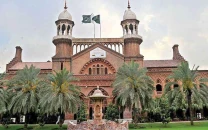PML-N presents economic ‘revival’ plan to its leadership
Recommendations include reducing income tax rates for salaried individuals but increasing corporate tax rates

The economic team of the PML-N has presented a plan to its leadership to tackle growing budget and external sector imbalances through a combination of increase in tax revenues, cut in expenditures and import restrictions.
The recommendations also include reducing the income tax rates for salaried individuals but increasing corporate tax rates in addition to reducing the electricity prices by 40% to encourage consumption.
The plan, presented to PML-N President Shehbaz Sharif a few days ago, who will likely be the next prime minister in case a no-confidence move succeeds against Premier Imran Khan, seems targeting the current account deficit by first controlling the budget deficit.
The higher budget deficit and the current account deficit have forced every government to knock the International Monetary Fund (IMF) door after assuming power since 2008. It is in fact the budget deficit that leads to higher current account deficit, former finance minister Miftah Ismail said.
In the short term, there is no way out except remaining in the IMF programme until it expires, Ismail said while speaking at Express News show – The Review.
Miftah could take the reign of the finance ministry until ex-finance minister Ishaq Dar returns to Pakistan, provided opposition succeeds in defeating PM Imran.
The immediate challenge for the new economic team will be handling the external sector that is getting out of control with the current account deficit increasing with an average of $1.5 billion a month during the first eight months of the fiscal year and the foreign exchange reserves slipping below two-month imports cover. At this pace, the current account deficit is expected to reach $20.6 billion by the end of the fiscal year, Ismail said.
According to the PML-N’s assessment shared with its leadership, the fiscal deficit will be over 8% of GDP or Rs4.4 trillion by the end of this fiscal year – higher by Rs1 trillion or 1.7% of the GDP against the PTI’s budget estimates. The projected 8% of the GDP budget deficit is also higher than 6.6% booked in 2018.
The PML-N’s economic team has also projected that the trade deficit will be $45 billion by June this year – highest in Pakistan’s history and also $8 billion more than what the PML-N had left behind.
The projections also showed that exports by June this year will be sufficient to cover only 40% of imports – down 10% from the level PML-N had left behind.
According to the PML-N’s assessment, the current account deficit could be around 5.5% of GDP by June, which will be slightly better than 6% of the GDP at the end of the PML-N tenure.
Read: Salaried class tax burden
Planning Minister Asad Umar said on Friday that it will be difficult for any new government to handle the external sector situation – a statement that puts question mark on the performance of incumbent Finance Minister Shaukat Tarin.
Annual debt servicing in Pakistan has increased from Rs1.5 trillion to over Rs3 trillion, primarily because PTI has increased debt by 66% and increased average interest rates by 50%, according to the PML-N’s assessment.
Does PML-N have a solution?
There is a need to limit the budget deficit to 4% of GDP and achieve 6% GDP growth, which would provide a permanent solution to the external sector problems, Ismail said.
It is not difficult to raise the tax-to-GDP ratio by over 2% over the medium term and also reduce both provincial and federal expenses by about 2% of GDP or Rs1.1 trillion, the PML-N recipe suggests.
In a growing economy, there should be a current account deficit up to what the world is willing to finance and this level is 1.5% to 2% of GDP, which is sustainable, Ismail said.
The PML-N team also plans to introduce import restrictions and increase exports through incentives. However, the PTI has implemented a similar strategy but it has not worked — thanks to rent- seeking industrialists who are more interested in selling goods in the local market than going abroad.
The PML-N may continue with interest and energy concessions for exporters but could stop further development of import substitution or manufacturing-for-local-consumption industry.
Its plan to increase tax collection is based on restructuring the tax base through reduction in individual income tax slabs and rates and increase in corporate income taxes for a few selected industries, but only those with high regulatory barriers to entry.
The PML-N could also bring the idea of charging a fixed sales tax on industry based on their sales the previous year and a fixed sales tax for every shop in Pakistan. But this plan may meet resistance from the World Bank and the IMF that are always in favour of a value-added sales tax.
The economic team has suggested to its leadership to first bring reforms in the NEPRA and OGRA – the power and gas sector regulators – in order to make privatisation of DISCOs and the Sui gas companies viable.
Ideally, NEPRA and OGRA should be shut down and an office should be established within the Ministry of Energy which would independently give advice to the premier on the determination of power and gas tariffs in the country, according to the PML-N’s assessment. However, this plan may meet resistance from the international lenders that advocate separate regulatory bodies.
Privatisation of all inefficient furnace oil-based power generation companies, Pakistan International Airlines and Pakistan Steel Mills are also on the PML-N’s to-do list. It had attempted to privatise these entities last time but ended up selling stakes of profitable companies at the stock market.
The team also suggested either privatising or shutting hundreds of state-owned enterprises that are making losses. Similarly, it has suggested to the leadership that the tracks of the Pakistan Railways should be owned and operated by a government company while the train and cargo services should be privatised.
At the back end of the privatisation programme, OGDCL, PPL and PSO should also be privatised, according to the recommendation.
It has also recommended reducing the electricity tariffs from Rs20 per unit to Rs12 per unit to encourage more consumption of the surplus electricity and provide some relief. The annual cost to the government is estimated at Rs300 billion.



















COMMENTS
Comments are moderated and generally will be posted if they are on-topic and not abusive.
For more information, please see our Comments FAQ